
‘Doctor Who’ is a series that has a long history of dabbling with the horror genre. Whether it’s for a single episode or the years long tenure of a given showrunner, the show established it’s reputation very early on as something you’d watch with one hand over your eyes. Ask anyone who grew up on it, and they’ll tell you about the first time a Dalek or an Auton set them diving behind the sofa. So what better time than Halloween to celebrate the spine-tingling history of our favorite time traveler by putting together a list of his ten scariest adventures?
I’ve done my best to avoid spoilers whenever possible, since each of the episodes listed is well worth experiencing for yourself. So if you’re the kind of person who worries about spoilers for forty year old TV shows, consider yourself warned. For the rest of you? Allons-y!
10 – ‘Terror of the Autons’ (1971)
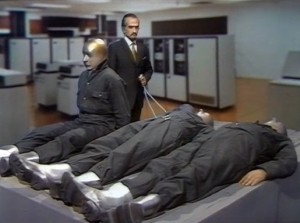 The oldest story on this list by several years, ‘Terror of the Autons’ features both the return of the Nestenes and the first appearance of the Master. The rogue Time Lord arrives on Earth and allies himself with the Nestene Consciousness, aiding the Nestenes in taking control of a plastics factory. The story’s creep factor comes into play when the Nestene Autons emerge in the latter half. Whereas in their prior appearance they were limited to the iconic shop window mannequins, ‘Terror’ sees the Nestenes take control of any and every piece of plastic produced by this factory. Beyond the familiar mannequins (themselves as unnerving as ever), this includes everything from plastic flowers to inflatable chairs, not to mention some truly hideous dolls. While some might argue for the elegant simplicity of mannequins come to life as a scare tactic, ‘Terror of the Autons’ opts for the broader horror of everyday items turning against you. In doing so, it takes everything that worked when we first saw the Autons a year prior and turns it up to eleven. ‘Doctor Who’ has long had a tradition of finding horror in the mundane, and seldom has it been more effective.
The oldest story on this list by several years, ‘Terror of the Autons’ features both the return of the Nestenes and the first appearance of the Master. The rogue Time Lord arrives on Earth and allies himself with the Nestene Consciousness, aiding the Nestenes in taking control of a plastics factory. The story’s creep factor comes into play when the Nestene Autons emerge in the latter half. Whereas in their prior appearance they were limited to the iconic shop window mannequins, ‘Terror’ sees the Nestenes take control of any and every piece of plastic produced by this factory. Beyond the familiar mannequins (themselves as unnerving as ever), this includes everything from plastic flowers to inflatable chairs, not to mention some truly hideous dolls. While some might argue for the elegant simplicity of mannequins come to life as a scare tactic, ‘Terror of the Autons’ opts for the broader horror of everyday items turning against you. In doing so, it takes everything that worked when we first saw the Autons a year prior and turns it up to eleven. ‘Doctor Who’ has long had a tradition of finding horror in the mundane, and seldom has it been more effective.
9 – ‘State of Decay’ (1980)
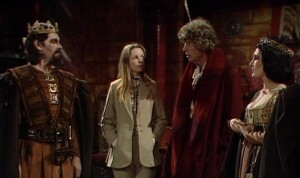 An extremely atmospheric story, ‘State of Decay’ represents at throwback to the program’s flirtation with gothic horror at a time when the producers favored more of a hard sci-fi approach. Even the music is on point in this story, which is no faint praise given that for much of the classic series, the incidental music could generously be described as a mixed bag. The first hint of mystery comes when K-9 detects advanced technology in what the Doctor describes as a “typical medieval scene”. As the Doctor and Romana investigate the village, the puzzle pieces fall into place when they meet the local Lords, who are quickly revealed as… vampires! This revelation brings with it what may be the single greatest piece of backstory in the history of ‘Doctor Who’: an ancient war between the Time Lords and a race of giant vampires, just one of whom could drain the life from an entire planet. Let me repeat that for you. A Time Lord / Vampire war. If that doesn’t set your imagination ablaze, this may not be the show for you! As the Lords plot to revive one of these ancient titans, the Doctor must rally the villagers and find a way to end the monster once and for all.
An extremely atmospheric story, ‘State of Decay’ represents at throwback to the program’s flirtation with gothic horror at a time when the producers favored more of a hard sci-fi approach. Even the music is on point in this story, which is no faint praise given that for much of the classic series, the incidental music could generously be described as a mixed bag. The first hint of mystery comes when K-9 detects advanced technology in what the Doctor describes as a “typical medieval scene”. As the Doctor and Romana investigate the village, the puzzle pieces fall into place when they meet the local Lords, who are quickly revealed as… vampires! This revelation brings with it what may be the single greatest piece of backstory in the history of ‘Doctor Who’: an ancient war between the Time Lords and a race of giant vampires, just one of whom could drain the life from an entire planet. Let me repeat that for you. A Time Lord / Vampire war. If that doesn’t set your imagination ablaze, this may not be the show for you! As the Lords plot to revive one of these ancient titans, the Doctor must rally the villagers and find a way to end the monster once and for all.
8 – ‘Mummy on the Orient Express’ (2014)
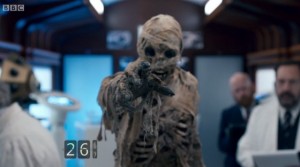 Writer Jamie Mathieson was reportedly told to “Hinchcliffe the shit out of” this one – referring to the producer who shepherded the show through the early Tom Baker years and whose taste for gothic horror left a mark on the program that is still felt today – and it shows. Drawing on both the gothic flavor of the Hinchcliffe era and on work of Agatha Christie, the episode is vintage ‘Who’ horror transplanted into the modern era. The story finds the Doctor and Clara on board a spacefaring replica of the Orient Express. One by one, the staff and passengers alike are killed, seemingly at random, inexorably pursued by a mummy that only they can see. This begins with a memorable sequence that cuts between the Foretold’s pursuit of its first victim and the Doctor explaining the “rules” – according to myth – of what happens when the creature appears. The appearance of the mummy is accompanied by a timer, counting down to the next death, which only adds to the chilling air of inevitability that accompanies the creature’s arrival.
Writer Jamie Mathieson was reportedly told to “Hinchcliffe the shit out of” this one – referring to the producer who shepherded the show through the early Tom Baker years and whose taste for gothic horror left a mark on the program that is still felt today – and it shows. Drawing on both the gothic flavor of the Hinchcliffe era and on work of Agatha Christie, the episode is vintage ‘Who’ horror transplanted into the modern era. The story finds the Doctor and Clara on board a spacefaring replica of the Orient Express. One by one, the staff and passengers alike are killed, seemingly at random, inexorably pursued by a mummy that only they can see. This begins with a memorable sequence that cuts between the Foretold’s pursuit of its first victim and the Doctor explaining the “rules” – according to myth – of what happens when the creature appears. The appearance of the mummy is accompanied by a timer, counting down to the next death, which only adds to the chilling air of inevitability that accompanies the creature’s arrival.
7 – ‘Horror of Fang Rock’ (1977)
 Fang Rock: home to an isolated lighthouse, shrouded in fog. After a meteor (or is it?) falls nearby, the lighthouse begins to suffer mysterious electrical failures and one of the keepers is found dead, his body looking as if it had been dissected. Meanwhile, the electrical problems lead a yacht to run aground. The passengers take shelter at the lighthouse. But the it’s hardly the haven they’d hoped for, as something begins to pick the group off one by one, electrocuting them to death. When the Doctor discovers the body – dead for hours – of a man he spoke with only moments ago, he realizes that the creature is a shapeshifter, and that he has inadvertently locked it in the lighthouse with the human survivors. Coming towards the end of a period in which ‘Doctor Who’ found itself infatuated with gothic horror, this story represents something of a mastery of the form, with the isolation and claustrophobia of the setting only enhancing the effect. And if the atmosphere isn’t enough, the story is a veritable bloodbath on top of it.
Fang Rock: home to an isolated lighthouse, shrouded in fog. After a meteor (or is it?) falls nearby, the lighthouse begins to suffer mysterious electrical failures and one of the keepers is found dead, his body looking as if it had been dissected. Meanwhile, the electrical problems lead a yacht to run aground. The passengers take shelter at the lighthouse. But the it’s hardly the haven they’d hoped for, as something begins to pick the group off one by one, electrocuting them to death. When the Doctor discovers the body – dead for hours – of a man he spoke with only moments ago, he realizes that the creature is a shapeshifter, and that he has inadvertently locked it in the lighthouse with the human survivors. Coming towards the end of a period in which ‘Doctor Who’ found itself infatuated with gothic horror, this story represents something of a mastery of the form, with the isolation and claustrophobia of the setting only enhancing the effect. And if the atmosphere isn’t enough, the story is a veritable bloodbath on top of it.
6 – ‘Revelation of the Daleks’ (1985)
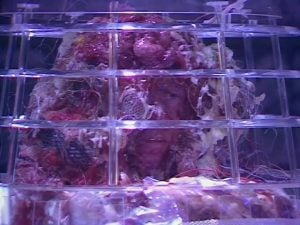 The Sixth Doctor’s era is noted for many things, but the quality of its stories isn’t generally one of them. At least, not in any way you’d want to brag about. But there are exceptions to every rule, and ‘Revelation’ stands as a testament to what this era could have been. The TARDIS lands on the mortuary planet Necros, and before long the Doctor is attacked by a hideously mutated individual who, when pacified, explains that he has been subjected to the experiments of someone called “the Great Healer”. The audience soon learns that the Great Healer is none other than Davros, and that his experiments involve transforming the people interred on Necros into Daleks. While later episodes have toyed with this idea (including, notably, Jenna Coleman’s surprise appearance in ‘Asylum of the Daleks’), it is presented here in a far more graphic and unsettling manner. And if that were the extent of the story’s horror, that would be more than enough to put it in the running for this list. But there’s more! Over the course of the story, we watch Davros twist and manipulate a woman until she brutally murders a man with whom she had been in (unrequited) love. And finally, we learn how Davros established his reputation and status on Necros: He developed a protein concentrate that was used to end a famine. Sounds benign. Boring, even. Right? Well, it turns out that “protein concentrate” was created using the bodies of anyone deemed “unworthy” of becoming a Dalek.
The Sixth Doctor’s era is noted for many things, but the quality of its stories isn’t generally one of them. At least, not in any way you’d want to brag about. But there are exceptions to every rule, and ‘Revelation’ stands as a testament to what this era could have been. The TARDIS lands on the mortuary planet Necros, and before long the Doctor is attacked by a hideously mutated individual who, when pacified, explains that he has been subjected to the experiments of someone called “the Great Healer”. The audience soon learns that the Great Healer is none other than Davros, and that his experiments involve transforming the people interred on Necros into Daleks. While later episodes have toyed with this idea (including, notably, Jenna Coleman’s surprise appearance in ‘Asylum of the Daleks’), it is presented here in a far more graphic and unsettling manner. And if that were the extent of the story’s horror, that would be more than enough to put it in the running for this list. But there’s more! Over the course of the story, we watch Davros twist and manipulate a woman until she brutally murders a man with whom she had been in (unrequited) love. And finally, we learn how Davros established his reputation and status on Necros: He developed a protein concentrate that was used to end a famine. Sounds benign. Boring, even. Right? Well, it turns out that “protein concentrate” was created using the bodies of anyone deemed “unworthy” of becoming a Dalek.
5 – ‘Silence in the Library’ / ‘Forest of the Dead’ (2008)
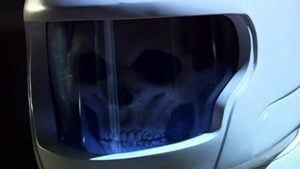 Just as classic ‘Who’ had its fondness for gothic, Hammer-esque horror, so too does the show’s modern incarnation have its own preferences. Especially effective is the approach favored by current showrunner Steven Moffat, which often emphasizes the terror of the mundane. Yes, ‘Doctor Who’ has long had a tradition of doing exactly that, but Moffat has elevated it to an art form. From statues to wi-fi, few stones have been left unturned. In this legendary two-parter, though, Moffat tackled what may be the most primal of human fears: the dark. The Doctor arrives at the Library – an entire planet dedicated to information storage, supposedly including every book ever written – to find it deserted, the only clue to what happened being a cryptic warning to “count the shadows”. The culprit? Swarms of Vashta Nerada, microscopic life forms that could best be described as carnivorous shadows. “Not every shadow, but any shadow” can be full of Vashta Nerada, and once they latch on to you? “Hey, who turned out the lights?” The only sanctuary is the light, and enough Vashta Nerada can block it out, casting entire corridors into pitch darkness in moments. And of course, even the best lamp can only help so much when you’re running for your life on a planet of killer shadows…
Just as classic ‘Who’ had its fondness for gothic, Hammer-esque horror, so too does the show’s modern incarnation have its own preferences. Especially effective is the approach favored by current showrunner Steven Moffat, which often emphasizes the terror of the mundane. Yes, ‘Doctor Who’ has long had a tradition of doing exactly that, but Moffat has elevated it to an art form. From statues to wi-fi, few stones have been left unturned. In this legendary two-parter, though, Moffat tackled what may be the most primal of human fears: the dark. The Doctor arrives at the Library – an entire planet dedicated to information storage, supposedly including every book ever written – to find it deserted, the only clue to what happened being a cryptic warning to “count the shadows”. The culprit? Swarms of Vashta Nerada, microscopic life forms that could best be described as carnivorous shadows. “Not every shadow, but any shadow” can be full of Vashta Nerada, and once they latch on to you? “Hey, who turned out the lights?” The only sanctuary is the light, and enough Vashta Nerada can block it out, casting entire corridors into pitch darkness in moments. And of course, even the best lamp can only help so much when you’re running for your life on a planet of killer shadows…
4 – ‘The Caves of Androzani’ (1984)
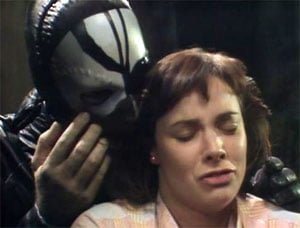 This one almost didn’t make the list. Not because it’s a bad episode. On the contrary, it’s quite possibly one of the finest hours in the history of ‘Doctor Who’. But for the most part it’s not especially scary. Oh, it’s unbelievably intense, but that’s mostly in a “high stakes action” kind of way. But there are certain scenes that make such an impact that I finally realized there was no way I couldn’t include ‘Caves’. The Doctor and Peri are both dying of spectrox poisoning. In order to retrieve the cure, the Doctor is forced to leave Peri in the company of antagonist Sharaz Jek. Jek, disfigured and insane, is immediately obsessed with Peri, but perhaps moreso with the idea of her and her beauty. This is clearly a man who hasn’t seen a woman in a very long time, and it manifests in as creepy a way as you might expect. If that doesn’t sound like something that merits inclusion on a list like this, try watching their scenes. Every second of screen time that the two share is supremely uncomfortable. Jek is constantly inserting himself into Peri’s personal space, much to her (extremely clear) discomfort and generally leaves little doubt in the viewer’s mind as to what will happen to her if the Doctor fails to return. Just writing about these scenes is enough to make my skin crawl.
This one almost didn’t make the list. Not because it’s a bad episode. On the contrary, it’s quite possibly one of the finest hours in the history of ‘Doctor Who’. But for the most part it’s not especially scary. Oh, it’s unbelievably intense, but that’s mostly in a “high stakes action” kind of way. But there are certain scenes that make such an impact that I finally realized there was no way I couldn’t include ‘Caves’. The Doctor and Peri are both dying of spectrox poisoning. In order to retrieve the cure, the Doctor is forced to leave Peri in the company of antagonist Sharaz Jek. Jek, disfigured and insane, is immediately obsessed with Peri, but perhaps moreso with the idea of her and her beauty. This is clearly a man who hasn’t seen a woman in a very long time, and it manifests in as creepy a way as you might expect. If that doesn’t sound like something that merits inclusion on a list like this, try watching their scenes. Every second of screen time that the two share is supremely uncomfortable. Jek is constantly inserting himself into Peri’s personal space, much to her (extremely clear) discomfort and generally leaves little doubt in the viewer’s mind as to what will happen to her if the Doctor fails to return. Just writing about these scenes is enough to make my skin crawl.
3 – ‘The Brain of Morbius’ (1976)
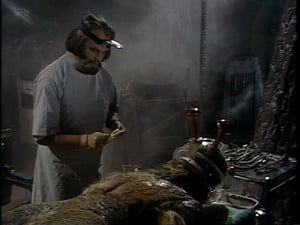 Drawing as many ‘Who’ stories of the period did on the influence of the Hammer school of gothic horror, ‘The Brain of Morbius’ is one of the finest examples of just what it was that makes the Hinchcliffe/Holmes era such a golden age for the program. The story, which essentially boils down to “Doctor Who meets Frankenstein,” sees the Doctor and Sarah Jane land on Karn (revisited in recent years by Paul McGann and Peter Capaldi’s Doctors), apparently redirected to the world by the Time Lords. They are quickly met by Solon, a thoroughly mad scientist , and his hulking, hook-handed assistant Condo. It fast becomes clear that Solon is constructing a new body for Morbius – a long-dead Time Lord tyrant whom the Doctor calls “one of the most despicable, criminally minded wretches that ever lived.” Of course, this is no ordinary body, but rather a grotesque amalgam of parts from creatures unknown, and Solon decides that the Doctor is the perfect donor for the last piece he needs… the head! The story also sees Sarah temporarily blinded while rescuing the Doctor from the Sisterhood of Karn (none too fond of Time Lords after the depredations of Morbius). An especially chilling sequence has the blind woman quite literally stumble across Morbius (currently existing as a disembodied brain) as he and Solon plot to lead the Doctor into a trap. Desperate to warn the Doctor, Sarah is forced to brave the hazards of Karn’s surface alone.
Drawing as many ‘Who’ stories of the period did on the influence of the Hammer school of gothic horror, ‘The Brain of Morbius’ is one of the finest examples of just what it was that makes the Hinchcliffe/Holmes era such a golden age for the program. The story, which essentially boils down to “Doctor Who meets Frankenstein,” sees the Doctor and Sarah Jane land on Karn (revisited in recent years by Paul McGann and Peter Capaldi’s Doctors), apparently redirected to the world by the Time Lords. They are quickly met by Solon, a thoroughly mad scientist , and his hulking, hook-handed assistant Condo. It fast becomes clear that Solon is constructing a new body for Morbius – a long-dead Time Lord tyrant whom the Doctor calls “one of the most despicable, criminally minded wretches that ever lived.” Of course, this is no ordinary body, but rather a grotesque amalgam of parts from creatures unknown, and Solon decides that the Doctor is the perfect donor for the last piece he needs… the head! The story also sees Sarah temporarily blinded while rescuing the Doctor from the Sisterhood of Karn (none too fond of Time Lords after the depredations of Morbius). An especially chilling sequence has the blind woman quite literally stumble across Morbius (currently existing as a disembodied brain) as he and Solon plot to lead the Doctor into a trap. Desperate to warn the Doctor, Sarah is forced to brave the hazards of Karn’s surface alone.
2 – ‘Blink’ (2007)
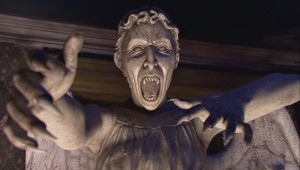 Yeah, we all knew this was going to make the list. I mean come on, it’s ‘Blink’. And really, what is there to say about ‘Blink’ that hasn’t been said a thousand times before? This episode is arguably the best that the post-2005 ‘Doctor Who’ has to offer, and it presents the Weeping Angels (arguably the best monsters the new series has to offer) in top form, years before the diminishing returns of their subsequent appearances. For the uninitiated (all five of you), ‘Blink’ features the Tenth Doctor only in a supporting role, mostly limited to communicating with the episode’s main character, Sally Sparrow, through a series of unusual DVD extras. Meanwhile, Sally unwittingly comes into possession of a TARDIS key, and is as a result hunted by the Angels. The Angels themselves are “creatures of the abstract”, who can move unbelievably fast but turn to stone when you look at them. That is the heat of what makes ‘Blink’ scary. It’s not just that Moffat found a way to make statues creepy, but the fact that something as fast as the blink of an eye is enough for them to kill you. That is the genius of ‘Blink’. It turns your own body against you. After all, who among us hasn’t tried to hold our breath when the characters we’re watching have to do the same? ‘Blink’ will leave you fighting to keep your eyes open any time the Angels are on screen.
Yeah, we all knew this was going to make the list. I mean come on, it’s ‘Blink’. And really, what is there to say about ‘Blink’ that hasn’t been said a thousand times before? This episode is arguably the best that the post-2005 ‘Doctor Who’ has to offer, and it presents the Weeping Angels (arguably the best monsters the new series has to offer) in top form, years before the diminishing returns of their subsequent appearances. For the uninitiated (all five of you), ‘Blink’ features the Tenth Doctor only in a supporting role, mostly limited to communicating with the episode’s main character, Sally Sparrow, through a series of unusual DVD extras. Meanwhile, Sally unwittingly comes into possession of a TARDIS key, and is as a result hunted by the Angels. The Angels themselves are “creatures of the abstract”, who can move unbelievably fast but turn to stone when you look at them. That is the heat of what makes ‘Blink’ scary. It’s not just that Moffat found a way to make statues creepy, but the fact that something as fast as the blink of an eye is enough for them to kill you. That is the genius of ‘Blink’. It turns your own body against you. After all, who among us hasn’t tried to hold our breath when the characters we’re watching have to do the same? ‘Blink’ will leave you fighting to keep your eyes open any time the Angels are on screen.
“Good luck.”
1 – ‘Midnight’ (2008)
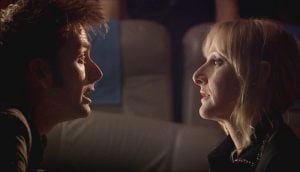 And here we are, at number one. And I realize some of you may be surprised that I went with ‘Midnight’ over ‘Blink’. But there’s a very simple reason for that. While it wouldn’t be hard to argue that ‘Blink’ is the better episode, this isn’t a list of “best” episodes. It’s a list of the scariest. And ‘Midnight’ is a scarier hour of television than ‘Blink’. On the leisure planet Midnight, the Doctor boards a tour bus to see the sights. When the bus is attacked by a mysterious entity that possesses people, mimicking and stealing their voices (for purposes unknown), the passengers turn on each other, descending into fear and paranoia. In fact, it could be argued (in a twist reminiscent of ‘The Twilight Zone’) that the real monster in this story isn’t the Midnight Entity itself but rather the human passengers whose paranoia and rush to judgment nearly dooms not only the Doctor but themselves along with him. Even with that in mind, the episode would not be half as effective as it is were it not for the performances of all involved, especially David Tennant as the Doctor and Lesley Sharp as a passenger possessed by the entity. The episode’s scariness also hinges on the fact that the entity renders the Doctor powerless as it begins to attack him. This is effective enough on its own, but at no point in the episode does the Doctor recognize the Midnight Entity, nor does he ever learn what, exactly, it is. While it wasn’t unusual in the classic series for the Doctor to have little if any prior knowledge of the threats he faced or the planets he visited, the 2005 revival took a somewhat different approach, presenting the Doctor as more of a know-it-all, often providing an info dump once he realizes what’s going on. ‘Midnight’ neatly subverts all of that by keeping him ignorant, and in doing so robs the audience of a “security blanket” of sorts that they had come to expect over the course of four seasons.
And here we are, at number one. And I realize some of you may be surprised that I went with ‘Midnight’ over ‘Blink’. But there’s a very simple reason for that. While it wouldn’t be hard to argue that ‘Blink’ is the better episode, this isn’t a list of “best” episodes. It’s a list of the scariest. And ‘Midnight’ is a scarier hour of television than ‘Blink’. On the leisure planet Midnight, the Doctor boards a tour bus to see the sights. When the bus is attacked by a mysterious entity that possesses people, mimicking and stealing their voices (for purposes unknown), the passengers turn on each other, descending into fear and paranoia. In fact, it could be argued (in a twist reminiscent of ‘The Twilight Zone’) that the real monster in this story isn’t the Midnight Entity itself but rather the human passengers whose paranoia and rush to judgment nearly dooms not only the Doctor but themselves along with him. Even with that in mind, the episode would not be half as effective as it is were it not for the performances of all involved, especially David Tennant as the Doctor and Lesley Sharp as a passenger possessed by the entity. The episode’s scariness also hinges on the fact that the entity renders the Doctor powerless as it begins to attack him. This is effective enough on its own, but at no point in the episode does the Doctor recognize the Midnight Entity, nor does he ever learn what, exactly, it is. While it wasn’t unusual in the classic series for the Doctor to have little if any prior knowledge of the threats he faced or the planets he visited, the 2005 revival took a somewhat different approach, presenting the Doctor as more of a know-it-all, often providing an info dump once he realizes what’s going on. ‘Midnight’ neatly subverts all of that by keeping him ignorant, and in doing so robs the audience of a “security blanket” of sorts that they had come to expect over the course of four seasons.
And there we have it! Which ‘Doctor Who’ episodes give you chills? What episodes would have made your top ten? Let us know in the comments, and remember: Don’t blink!
